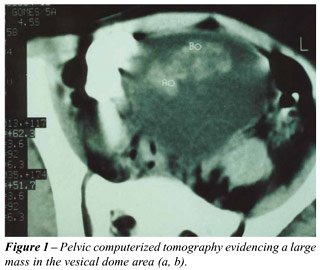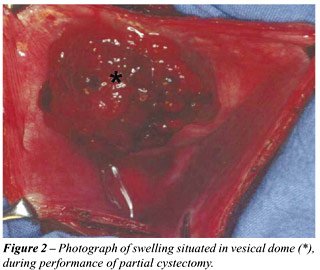VESICAL
HEMANGIOMA IN PATIENT WITH KLIPPEL-TRENAUNAY-WEBER SYNDROME
(
Download pdf )
LUCIANO A. FAVORITO
Urogenital Research Unit, State University of Rio de Janeiro (UERJ), Rio de Janeiro, RJ, Brazil
ABSTRACT
Klippel-Trenaunay-Weber
syndrome is characterized by cutaneous hemangiomas, varicosity and bony
hypertrophy of extremities. Urinary tract hemangiomas may occur in 3 to
6% of these patients. This work intends to report a case of a patient
with a huge vesical hemangioma, who presented this syndrome.
A 5 year-old boy with Klippel syndrome sought
our services due to 3 episodes of gross hematuria in the past 30 days.
Excretory urography and computerized tomography were performed, indicating
the presence of a swelling in vesical dome. An exploratory cystotomy was
conducted and the dark colored mass in vesical dome was excised by partial
cystectomy. The histopathologic finding confirmed that it was a vesical
hemangioma. Though rare, urinary tract hemangiomas must always be considered
in patients with Klippel-Trenaunay syndrome.
Key
words: bladder; hemangioma; Klippel-Trenaunay-Weber syndrome;
therapeutics
Int Braz J Urol. 2003; 29: 149-50
INTRODUCTION
The Klippel-Trenaunay-Weber syndrome is a syndrome due to vascular malformations, characterized by cutaneous hemangiomas, varicosities and bony hypertrophy of extremities (1). Lesions are present at birth and about 75% of patients manifest symptoms before 10 years old (2). In 3 to 6% of patients, there are urinary tract hemangiomas (3). This work intends to report the case of a patient with this syndrome who presented hematuria caused by a vesical hemangioma.
CASE REPORT
Male,
5 year-old patient, who presented Klippel-Trenaunay-Weber syndrome, sought
the urology service due to 2 episodes of gross hematuria in the past 30
days. Apart from characteristic syndromic changes (cutaneous hemangiomas
in lower limbs, hypertrophy of right lower limb and varices in lower limbs),
the patient did not present any other relevant finding on physical examination.
He was submitted to an ultrasonography of the urinary tract, which revealed
a huge mass in vesical dome, with characteristic signs of hemangioma.
An excretory urography was made, showing a large filling defect. The assessment
was complemented by abdominal and pelvic computerized tomography, which
showed a 4.0 x 3.5 cm mass in vesical dome (Figure-1).

Following the analysis of tests, it was
decided to perform a partial cystectomy. During exploratory cystotomy,
a dark colored mass was seen in vesical dome (Figure-2). The partial cystectomy
was made with a safety margin. The histopathologic finding confirmed that
it was a vesical hemangioma.

DISCUSSION
In
Klippel-Trenaunay-Weber syndrome, symptoms in genitourinary system occur
in the illness’ more severe forms, mainly in patients with visible
vascular lesions in trunk and pelvis (2). One of the most frequent symptoms
in these patients is hematuria, due to hemangiomas.
Vesical hemangiomas have an incidence of
less than 1% of the organ’s primary tumors, being, however, the
most common connective tissue benign tumor in bladder (3). Painless gross
hematuria is a characteristic of this type of tumor, as it was observed
in the present case (2).
In Klippel-Trenaunay-Weber syndrome, vesical
hemangiomas are frequent and preferably located on the bladder’s
anterior wall and vesical dome (2). Several treatments are proposed for
this lesion: fulguration or endoscopic excision (2), treatment with YAG-Laser
(3) and partial cystectomy. Endoscopic excision can lead to profuse bleeding,
and is contra-indicated (3), laser treatment is expensive and unavailable
in many centers, which makes partial cystectomy the treatment best suited
for this type of tumor.
Patients with Klippel-Trenaunay-Weber syndrome
who present hematuria must be investigated, as they can have urinary tract
hemangiomas.
REFERENCES
- Klein TW, Kaplan GW: Klippel-Trenaunay syndrome associated with urinary tract hemangiomas. J Urol. 1975; 114: 596-600.
- Furness III PD, Barqawi AZ, Bisignani G, Decter RM: Klippel-Trenaunay syndrome: 2 case reports and a review of genitourinary manifestations. J Urol. 2001; 166: 1418-20.
- Hockley NM, Bihrle R, Bennett III RM, Curry JM: Congenital genitourinary hemangiomas in a patient with the Klippel-Trenaunay syndrome: Management with the Nedymium:Yag-Laser. J Urol. 1989; 141: 940-1.
_________________________
Received: December 12, 2002
Accepted after revision: March 12, 2003
_______________________
Correspondence
address:
Dr. Luciano Alves Favorito
Rua Prof. Gabizo, 104 / 201
Rio de Janeiro, RJ, 20271-320, Brazil
Fax: + 55 21 3872-8802